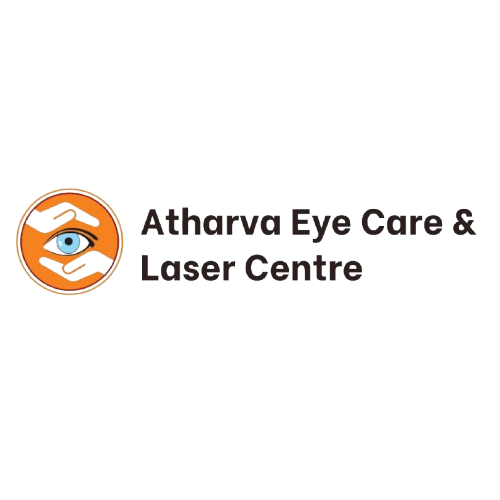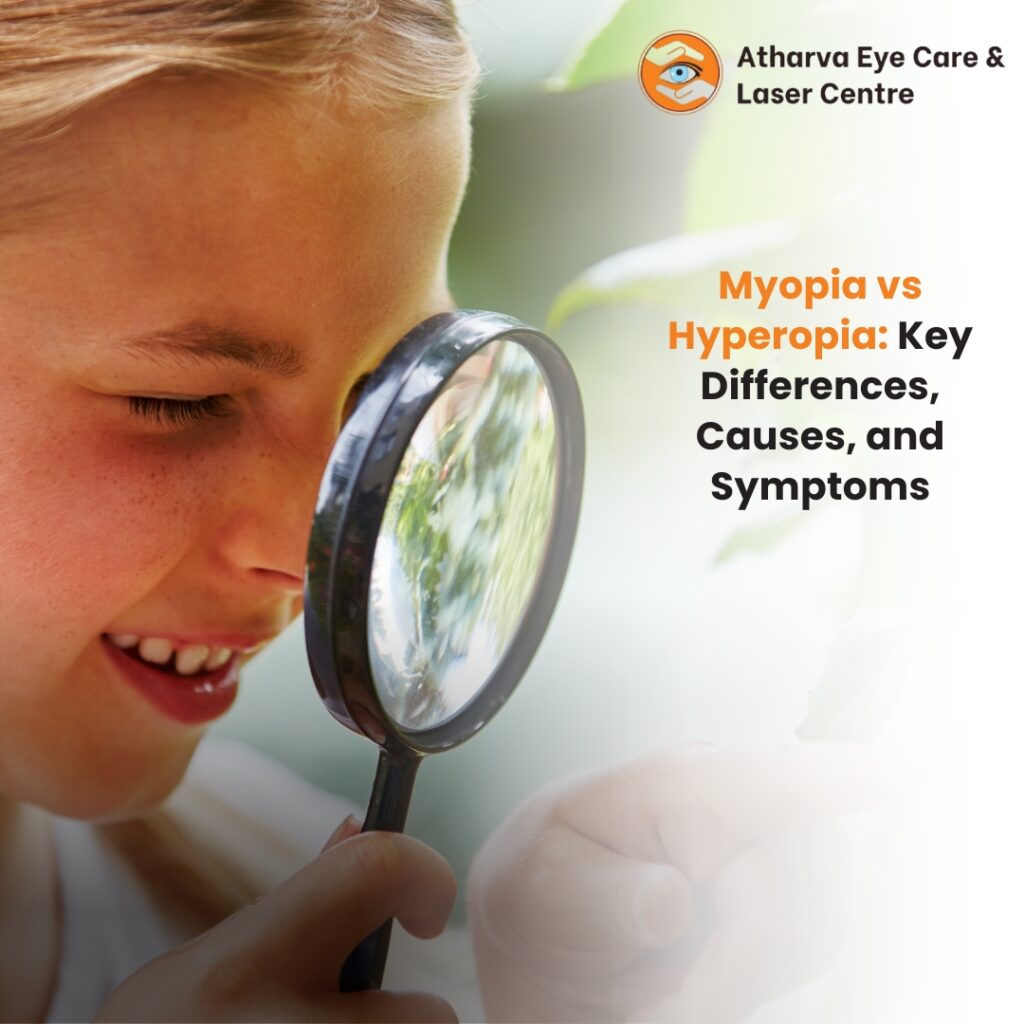- September 5, 2025
- By: atharvaeyeclinic.com
- No Comments
Myopia vs Hyperopia: Key Differences, Causes, and Symptoms
Good vision is essential for leading a comfortable and independent life. However, millions of people worldwide experience refractive errors that affect how clearly,they see objects. Two of the most common vision problems are Myopia (nearsightedness) and Hyperopia (farsightedness). While both conditions involve the eye’s inability to focus light properly, they differ in how they affect vision, their underlying causes, and the symptoms they present.
What is Myopia (Nearsightedness)?
Myopia is a condition where nearby objects appear clear, but distant objects look blurry. This happens when the eyeball is too long or the cornea is too curved, causing light to focus in front of the retina instead of directly on it.
Causes of Myopia:
- Genetics – If one or both parents are nearsighted, there is a higher chance their children will also develop myopia.
- Lifestyle factors – Prolonged screen time, excessive reading, or limited outdoor activity can contribute to its progression.
- Eye structure – An elongated eyeball or steep cornea curve can affect how light focuses.
Symptoms of Myopia:
- Difficulty seeing distant objects (e.g., road signs, classroom board)
- Squinting to improve vision
- Eye strain and headaches
- Needing to sit closer to screens or books
What is Hyperopia (Farsightedness)?
Hyperopia is the opposite of myopia. In this condition, distant objects are usually clearer, while close objects appear blurry. This occurs when the eyeball is too short or the cornea is too flat, causing light to focus behind the retina.
Causes of Hyperopia:
- Genetics – It often runs in families.
- Eye structure – Shorter eyeballs or flatter corneas can lead to farsightedness.
- Aging – Although hyperopia can be present at birth, it may worsen with age as the eye’s natural lens loses flexibility.
Symptoms of Hyperopia:
- Blurry vision when reading or doing close work
- Eye fatigue after prolonged near tasks
- Headaches, especially after using digital devices
- Difficulty focusing on nearby objects
Myopia vs Hyperopia: Key Differences
Aspect | Myopia (Nearsightedness) | Hyperopia (Farsightedness) |
Vision Clarity | Clear near vision, blurry distant vision | Clear distant vision, blurry near vision |
Light Focus Point | In front of the retina | Behind the retina |
Common Age Group | Often starts in childhood or teenage years | Can be present from birth, worsens with age |
Symptoms | Difficulty seeing far objects, squinting, headaches | Blurry near vision, eye strain, headaches |
Causes | Elongated eyeball, curved cornea, genetics, lifestyle | Short eyeball, flat cornea, genetics, aging |
How Are They Diagnosed?
Both myopia and hyperopia are diagnosed during a comprehensive eye examination by an ophthalmologist or optometrist. Common diagnostic methods include:
- Visual acuity test – Reading letters on a chart from various distances.
- Refraction test – Using lenses to determine the exact prescription needed.
- Retinal examination – Checking how light focuses on the retina.
Treatment Options
Thankfully, both myopia and hyperopia are easily treatable with several effective options:
- Eyeglasses
The most common and simplest method to correct vision. Concave lenses are used for myopia, while convex lenses are prescribed for hyperopia.
- Contact Lenses
A convenient option for those who prefer not to wear glasses. Contact lenses offer a wider field of vision and are available in various types (daily, monthly, toric, etc.).
- Refractive Surgery (LASIK, PRK, SMILE)
For those seeking a permanent solution, LASIK eye surgery and other laser procedures reshape the cornea to correct how light focuses on the retina.
- Lifestyle Modifications
- Limiting screen time and taking regular breaks (20-20-20 rule: every 20 minutes, look at something 20 feet away for 20 seconds).
- Spending more time outdoors to reduce myopia progression in children.
- Proper lighting while reading and working.
Can Myopia and Hyperopia Be Prevented?
While these conditions are largely genetic, certain habits can help maintain better eye health and reduce strain:
- Encourage children to play outdoors regularly.
- Practice good screen hygiene.
- Have regular eye check-ups, especially if there is a family history of vision problems.
- Eat a balanced diet rich in Vitamin A, Omega-3 fatty acids, and antioxidants for overall eye health.
When Should You See an Eye Specialist?
If you notice any of the following, it’s time to visit an eye clinic like Atharva Eye Clinic in Kalyan:
- Difficulty reading road signs or books clearly
- Frequent headaches or eye strain
- Blurry vision at near or far distances
- Children sitting too close to screens or books
Early diagnosis and timely treatment can prevent worsening of vision and improve quality of life.
Conclusion
Both myopia and hyperopia are common refractive errors that affect millions of people globally. The key difference lies in whether you struggle to see objects near or far. While myopia causes blurred distance vision, hyperopia makes close-up vision difficult. With modern treatment options like eyeglasses, contact lenses, and LASIK surgery, managing these conditions has become easier than ever.
At Atharva Eye Clinic, Kalyan, our experienced eye specialists provide comprehensive diagnosis and treatment for vision problems like myopia and hyperopia. Regular eye check-ups, early intervention, and proper care can help you enjoy clear, healthy vision at every stage of life.

